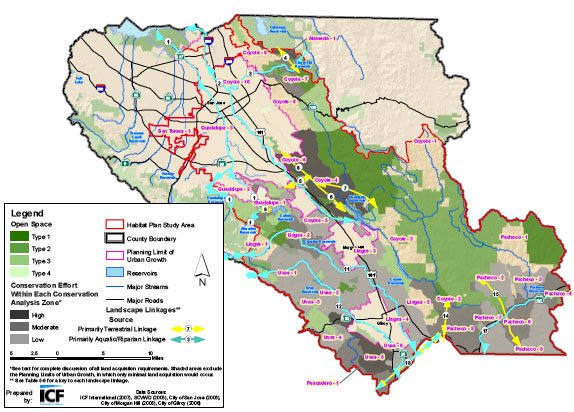Following hundreds of critical public comments and the City of
Gilroy’s controversial, temporary hiatus from the project,
significant changes could be on the way for a proposed 50-year
Santa Clara Valley Habitat Conservation Plan, including more than
$280 million in reductions and added reprieves for some private
development. Full story
Gay education bill met by local dissent
City responds to grand jury report
SJ mosquitoes test positive for West Nile Virus
Eyesore of the Week: Obata Way
Today’s breaking news:
Following hundreds of critical public comments and the City of Gilroy’s controversial, temporary hiatus from the project, significant changes could be on the way for a proposed 50-year Santa Clara Valley Habitat Conservation Plan, including more than $280 million in reductions and added reprieves for some private development.
But not everyone is praising the would-be revisions to the 2,800-page HCP, with some saying the changes aren’t enough and the project remains an unneeded, bureaucratic burden.
“While we appreciate the changes, we don’t think they go far enough,” said Jennifer Williams, executive director of the Santa Clara County Farm Bureau. “The plan is incredibly broad, incredibly expensive and an over-reach of government.”
The revisions were crafted by representatives from the project’s member agencies – the cities of Gilroy, Morgan Hill and San Jose, the Santa Clara Valley Transportation Authority, Santa Clara County and the Santa Clara Valley Water District – along with assistance from the U.S. Fish and Wildlife Service and the California Department of Fish and Game. Officials from the five partner organizations would form a Joint Powers Authority, which would handle all funds received related to the plan.
The habitat plan is intended to identify land occupied by endangered or threatened species and streamline the process to obtain permits to build on them. The plan currently covers 19 species, 11 of which are endangered.
The proposed changes include scaling back the project’s price tag from $941 million to just over $660 million by reducing the plan’s overall coverage by more than 8,000 acres to 49,453 acres mostly in South County. Development fees for encroaching on protected or endangered species’ areas would diminish by 16 percent, and penalties for private building on land not known to contain threatened wildlife would be eliminated altogether, according to Ken Schreiber, habitat plan program manager.
“There was a very strenuous effort to cut the cost down to the basic minimum,” Schreiber said. “The direction that the management team has established is that the general land cover fees shouldn’t in any way subsidize people who are generating impacts that cost a lot more to mitigate.”
The Gilroy City Council voted 4-3 on March 28 to opt out of the plan, with several councilmembers saying the plan didn’t address concerns Gilroyans had about the project. Mayor Al Pinheiro and Councilmen Perry Woodward, Bob Dillon and Dion Bracco voted to leave the project. Councilwoman Cat Tucker, who is the city’s liaison to the habitat plan, and Councilmen Peter Arellano and Peter Leroe-Muñoz voted to remain in the plan.
Six weeks later, the Council again voted 4-3, but with Pinheiro switching his vote to allow the city to rejoin the plan.
Schreiber called Gilroy’s decision to opt out “a good way to focus a lot of attention on issues that were important.”
If the agencies to decide to move forward and request to have a final plan, it could be adopted as early as next summer and implemented as early as January 2013, Schreiber said.
The Santa Clara Valley Water District board of directors will discuss the proposed changes tonight, and the Gilroy City Council will do the same next Monday.
Gilroy’s share in finishing the final plan could reach $50,000, nearly half of that spent on helping draft a U.S. Army Corps of Engineers permitting plan for wetlands not covered by the plan, Schreiber said.
While standard development fees would decline under the proposed revisions, fees for building on riparian and wetland areas would increase significantly.
Fees for building on seasonal wetlands would jump 18 percent to more than $343,000 per acre, and development along ponds with the plan area would increase 22 percent to more than $141,000 per acre.
“If you’re building on wetlands, those are inherently much more important to deal with,” Schreiber said, adding the areas were home to the endangered California Tiger Salamanders and tended to be travel corridors for other species.
Some, however, aren’t buying statements that that plan will actually save endangered species, and the topography where much of the threatened wildlife exists would prevent large-scale development, making the project unnecessary for the most part, Williams said.
“We’re not at all disputing that it’s a difficult process. But creating additional government is not going to benefits,” she said. “The plan has been touted as a streamlining process, but we just see it as an additional layer. We think it’s just going to be red tape on top of red tape.”
Jeff Martin, a farmer and landowner, and member of Gilroy’s Neighborhood District Committee and the HCP Stakeholder Committee, said any perceived benefits obtained through the plan wouldn’t be worth it.
“There are ways to have a plan without including a lot of future resources. The benefits sound better than they really are,” Martin said. “To commit decades to that is really a mistake.”
Santa Clara Valley Habitat Plan proposed changes
– Total project cost falls from $941 million to $660 million
– Private development not subject to fees unless it impacts sensitive habitat
– Scope of project reduced from 58,747 acres to 49,453 acres in Santa Clara County including Gilroy, Morgan Hill, San Martin, San Jose and adjacent rural lands
– Wetland-related special fees increase as much as 27 percent
SCVHP Economic Impactvar docstoc_docid=”94648197″;var docstoc_title=”SCVHP Economic Impact”;var docstoc_urltitle=”SCVHP Economic Impact”;
SCV Habitat Plan_Finalvar docstoc_docid=”94648237″;var docstoc_title=”SCV Habitat Plan_Final”;var docstoc_urltitle=”SCV Habitat Plan_Final”;















